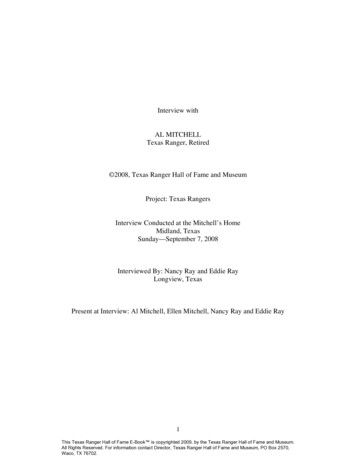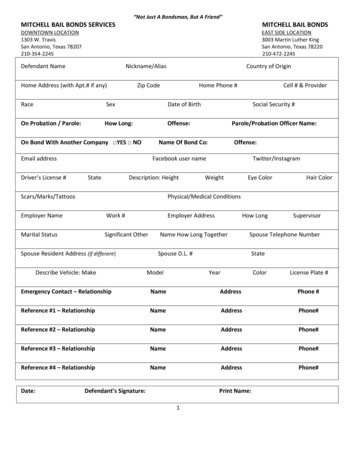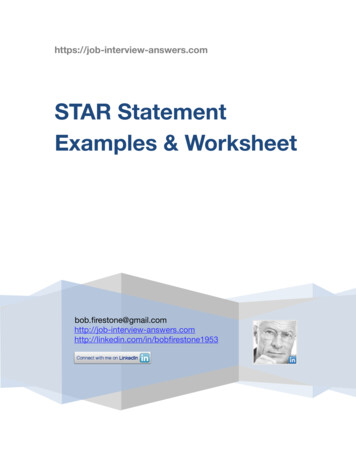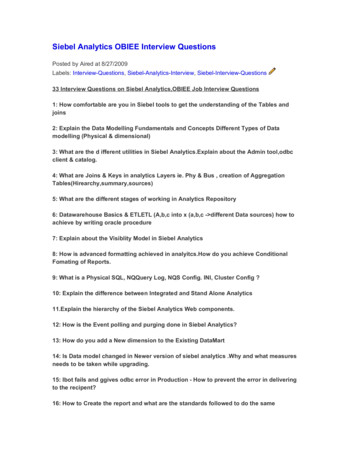
Transcription
Interview withAL MITCHELLTexas Ranger, Retired 2008, Texas Ranger Hall of Fame and MuseumProject: Texas RangersInterview Conducted at the Mitchell’s HomeMidland, TexasSunday—September 7, 2008Interviewed By: Nancy Ray and Eddie RayLongview, TexasPresent at Interview: Al Mitchell, Ellen Mitchell, Nancy Ray and Eddie Ray1This Texas Ranger Hall of Fame E-Book is copyrighted 2009, by the Texas Ranger Hall of Fame and Museum.All Rights Reserved. For information contact Director, Texas Ranger Hall of Fame and Museum, PO Box 2570,Waco, TX 76702.
IntroductionWelcome to the E-Book Project of the Texas Ranger Hall ofFame and Museum (TRHFM). The TRHFM, located in Waco,Texas, is the State-designated Official Historical Center of theTexas Rangers. It is operated as a service of City of Waco byauthorization of the Texas Department of Public Safety and theState of Texas.The mission of this project is to provide easy access to books, oral histories dissertations, articles,and other literary works on Texas Ranger history.Public Domain Works: Many of the works in this non-commercial library are in the publicdomain and may be freely enjoyed—please follow the conditions set forth below.Copyrighted Works: Some works, which are clearly noted, are under copyright. They arein this library through the courtesy and permission of the copyright holders. Please read andenjoy them, but they may not be redistributed, copied or otherwise used without the writtenpermission of the author or copyright holder.Conditions & Statements1. The Adobe Acrobat or other file format in which this work resides may not beredistributed for profit—including commercial redistribution, sales, rentals, or fees forhandling, access, download etc. These works may not be modified, changed or sued inderivative works in any manner without the express permission of the Texas Ranger Hall ofFame and Museum.2. The TRHFM staff has exercised due diligence to determine that this material is in thepublic domain or to secure copyright permission. If you believe this work is under copyright,and you are the copyright holder, please contact us at Texas Ranger Hall of Fame, PO Box2570, Waco, TX 76702-2570 with proof of ownership.3. You may link to the main page of the library, however, please do not "hot link" directly tothe files or repost them.4. If a work is redistributed for educational or nonprofit use, the following must remainintact: (1) The author/copyright holder credits (2) the registered name Texas Ranger Hall ofFame E-Book , (3) the logo and name Texas Ranger Hall of Fame and Museum .This Texas Ranger Hall of Fame E-Book is copyrighted 2009, by the Texas Ranger Hall of Fame and Museum.All Rights Reserved. For information contact Director, Texas Ranger Hall of Fame and Museum, PO Box 2570,Waco, TX 76702.
AL MITCHELLTEXAS RANGER, RETIREDNANCY RAY: My name is Nancy Ray and I’m visiting with Al Mitchell today and we are athis home (Midland, Texas, Sunday, September 7th, 2008). Also present are his wife Ellen andEddie Ray. The purpose of this interview is to discuss your career as a Ranger and RangerMitchell, do I have your permission to record this interview?AL MITCHELL: Of course.NANCY RAY: And, Ranger Mitchell, do you understand that this videotape will belong to theTexas Ranger Hall of Fame and Museum in Waco, Texas?AL MITCHELL: I do.NANCY RAY: And, Mr. Mitchell, do I have your permission to present copies of this video tovarious historical organizations such as museums, libraries, schools, and once transcribed, toplace them on the Texas Ranger Hall of Fame and Museum’s website?AL MITCHELL: Of course.NANCY RAY: All right, let’s begin by learning a little bit about you. What is your full name?AL MITCHELL: My name is A. L. Mitchell.NANCY RAY: OK, the, the A L, those are initials?AL MITCHELL: Initials.NANCY RAY: Do you have a full name or do you want to talk about it?AL MITCHELL: I don’t want to talk about it.NANCY RAY: That works.AL MITCHELL: Actually, my real name is Ashby, ASHBY, my middle name is Lige, but I’venever went by that name.NANCY RAY: How do you spell Lige?AL MITCHELL: LIGE, that was my grandfather.NANCY RAY: All right, well, that’s an honor to have your grandfather’s name. And youcurrently live here in Midland. Where were you born?2This Texas Ranger Hall of Fame E-Book is copyrighted 2009, by the Texas Ranger Hall of Fame and Museum.All Rights Reserved. For information contact Director, Texas Ranger Hall of Fame and Museum, PO Box 2570,Waco, TX 76702.
AL MITCHELL: I was born in Eddy County, New Mexico, on the Pecos River betweenCarlsbad and Artesia, near uh not far from the old town of Seven Rivers, just south of a littletown, Lakewood, uh, I was born in 1935.NANCY RAY: OK, did you go to school there? Did you grow up there?AL MITCHELL: I went to school the first two years in Lakewood and then uh went, wemoved into Carlsbad and I finished my high school, went through high school in Carlsbad, NewMexico.NANCY RAY: Did you have any favorite subjects?AL MITCHELL: (laughter) I just like to work.NANCY RAY: You like to work. No, you didn’t like any of the particular subjects in school?AL MITCHELL: Oh, you mean subjects in school?NANCY RAY: Right.AL MITCHELL: I really liked history, yeah. I’m kind of a history buff.NANCY RAY: That seems to be a trend with Rangers, it really does. What about sports oranything like that, were you active in that?AL MITCHELL: Well, you know, in another life and in a younger day, I used to rope a lot ofsteers and did a lot of cowboying but that was, that was a long time ago.NANCY RAY: Was that, did you do it like in a rodeo type setting?AL MITCHELL: Well, you know, I was on a rodeo team in college and I roped a lot of steers.I’d worked for, I worked for the New Mexico Livestock Commission one time for a few yearsand I roped a lot of steers and, and that was, that was in another life, my first inclination was thatI was going to be in the cow business. I never in my life thought I’d ever carry a gun or be apoliceman. I never had, never had even thought about being a policeman.NANCY RAY: My goodness. Well, before we get to your being a policeman, let’s talk aboutwhat were your parents’ names?AL MITCHELL: My mother’s name was Florence and my dad was named Buster, W. H.(Buster) Mitchell. Uh, they were, my dad was born and raised in Carlsbad uh, my mother wasborn south of Monahans on the Pecos River in 1908 in a tent. Uh, so I’m really a Llano Estacadoproduct from across West Texas and Southeastern New Mexico.NANCY RAY: OK.3This Texas Ranger Hall of Fame E-Book is copyrighted 2009, by the Texas Ranger Hall of Fame and Museum.All Rights Reserved. For information contact Director, Texas Ranger Hall of Fame and Museum, PO Box 2570,Waco, TX 76702.
AL MITCHELL: My, my grandfather and his brothers and their sister and their dad came outof Comanche County, Texas, in 1902 and went to the Pecos River where they established adredge business, or that was before there was any trucks, wagons and teams they was in thedredge business, the hauling business did a little bit of everything. Uh, actually, that businessprogressed into a trucking company and a house-moving company and in fact, my grandfatherreceived the first SCC permit that was ever issued in the state of New Mexico and bought thefirst truck that was ever sold in New Mexico. Way back there. And so, that’s where my familywas kind of raised in, on, there in Eddy County.NANCY RAY: Did you have brothers and sisters?AL MITCHELL: I have one brother, his name is Bill.NANCY RAY: Is he older or younger?AL MITCHELL: He’s six years older than I am. Uh, he currently lives in Kansas with his sonand grandsons.NANCY RAY: Well, very good. When you completed high school, what did you do then? Didyou go to the military or AL MITCHELL: Well, I got out, I graduated from high school in 1953 in Carlsbad and I wentto New Mexico State University for one year. And I came home and decided I wanted to makesome money, I was about to starve to death. And uh, so uh I uh, I got a job, actually before I hadleft Carlsbad, for a very short time I worked for the Fire Department. I was a paid fireman, oneof the first four in Carlsbad. But that didn’t last long, about a year or nine months and uh I hadalways wanted to be in the cow business, that’s what my real aim in life was and I intended to dothat and after I, I went to school for a year at New Mexico State and come back home and uh, Igot a job working in a potash mine as a welder and mechanic in the potash mine. And, and I haduh, I had a little piece of country leased out south of White City. I had about fifty head ofyearlings out there, I was gonna get in the cow business. I was day working when I wasn’tworking somewhere else on those ranches out there in that part of the county. And of course itdidn’t rain for that was during the time when it didn’t rain for five years price of cattle wentpretty bad. Uh, I was about to get drafted and so I sold my little bunch of cattle and I got out ofthe cow business and when I paid all my bills, I had 10 left. So I took my girlfriend to town andwe had a steak supper and I went to the Army.NANCY RAY: Oh my. Now what year was that when you went to the Army?AL MITCHELL: Let’s see, I went to the Army in 1956.NANCY RAY: OK. And did you, what did you do?AL MITCHELL: Well, it’s kind of a strange deal. I, I enlisted through the New MexicoNational Guard and went into the Army and stayed in the Army about 15 months before it was, it4This Texas Ranger Hall of Fame E-Book is copyrighted 2009, by the Texas Ranger Hall of Fame and Museum.All Rights Reserved. For information contact Director, Texas Ranger Hall of Fame and Museum, PO Box 2570,Waco, TX 76702.
was a limited enlistment type thing. I went, they sent me to school. I went to, I took my basictraining in Camp Chaffee Arkansas and they sent me back to Fort Bliss Texas in, and for someunknown reason, I never knew why, when I got my orders out of basic training, they specifiedthat they were gonna send me to Fort Bliss, Texas, to military intelligence school, S2, S3 school.I didn’t even know what that meant. I why in hell would you send a cowboy to militaryintelligence school? And so that’s what I did and I stayed in school the rest of my enlistmentperiod. And by the time I got out of school, I was so close to being out that I went ahead and,they went ahead and released me. I came back home and, I was trying to figure out how to getback in the cow business again and so ultimately I got a job as a deputy brand inspector, cattleinspector, for the state of New Mexico. And they sent me to Clovis to work in the stockyards andI stayed in Clovis eight months, inspecting cattle. At that time, there was four, four sale barnsoperating there. We were inspecting, about four days a week we were inspecting seven or eightthousand head of cattle a day.NANCY RAY: Now what were you inspecting for?AL MITCHELL: I was a brand inspector. Uh, the job of a brand inspector is to inspect cattlethat is being transported and sold and determine that they are properly branded and they are theproperty of the people that’s selling them or the people that’s selling them have the properdocuments to sell the cattle the title to the cattle so to speak. And basically that’s what the jobwas. It’s a quasi . And in New Mexico, it’s a, it’s a statutory job as opposed to Texas. TexasSouthwestern Cattle Raisers Association in Texas is an association, they have a fine organizationbut they have no laws. In New Mexico, the brand laws are state laws and so, actually we werecommissioned officers although I had little or no training as far as a police officer. I, the reason Iwanted that job is because I thought I could, if I was a brand inspector I could get close to thecattle business and I’d know what was going on everywhere and I could get back in the cowbusiness.NANCY RAY: Well, let me ask you, before you get too far into your career, when did youmarry?AL MITCHELL: That come later on.NANCY RAY: Ah, OK, well keep going.AL MITCHELL: I’ll get there. Uh, I stayed in Clovis eight months and they sent me, theycame down there one day and they asked me if I wanted to be a district inspector. And they toldme that they had an opening in Quemado, New Mexico. Now if you don’t know where that’s at,that’s 108 miles west of Socorro over there on the Arizona line in a, in a big old Gila Wilderness,wide open country. Uh and so, they didn’t know it the reason they asked me to go because Iwas the only single guy they had and there was, nobody with a family would move out there.There was not much of a place for kids to go to school although there was a school. But anyway,what they didn’t know is that I’d a went to hell to get out of Clovis. But, I accepted that job andthey sent me to Quemado which is a little town of about 300 people, as I said, way out there inthe Gila Wilderness, on Highway 60. My district was 150 miles long and a hundred miles wideand it had one paved road going across the middle of it and no telephones and 1750 people in5This Texas Ranger Hall of Fame E-Book is copyrighted 2009, by the Texas Ranger Hall of Fame and Museum.All Rights Reserved. For information contact Director, Texas Ranger Hall of Fame and Museum, PO Box 2570,Waco, TX 76702.
the whole area. That’s, the ranches out there, 70, 80, 90, 100 sections is a mediocre-size ranch inthat country. Lots of big ranches, lots of good cowboy time. And so I stayed out there for aboutthree and a half years and all the time trying to figure out how to get back in the cow business.There was a time in the, in the cattle business when a poor boy could, could pick him up a cowor two here, get a few cows here, raise them, put them on some patch somewhere where firstthing you know he’s got six or eight you know he can move them around, he can lease him alittle corner somewhere and run a few cows in it. First thing you know you’ve got 15 or 20, 30,40 head of cattle and then you kind of get started and get back in the cow business.Unfortunately, it was at that time in the history of this country that the Internal Revenue Servicefixed it where the people that had the money, had a lot of money, looking for places to writetaxes off, they, the tax laws fixed it so those people with the money that needed a tax write offcould buy a ranch and pay way more money than it was worth. In fact, they were not in theranching business to make money they were in the ranching business to lose money. Well, thataffected a poor boy like me trying to get in the business. Uh, and so, it became an impossibilityto do it the way we used to do it. And so, during the period of time I was out there, I got involvedin investigating some cattle theft cases, working some illegal transportation cases I had zerotraining. The only thing I knew about how to do that was I just knew the difference between rightand wrong. And that’s all I really knew. And so I stayed out there about three and a half yearsand I, at that time I think I was making 275 a month. And uh, I got acquainted with some StatePolice officers in New Mexico and they were making 325 a month. And after it became clear tome that I was not ever gonna get back in the cow business that way, I thought well if I’m gonnawork on this end of this deal, I just as well go where I can make some money and get sometraining. And so I applied and went to the State Police. And uhNANCY RAY: Would that be the equivalent of the Texas Highway Patrol at that time?AL MITCHELL: Well, the State Police is a uniformed State Police organization whichperforms all of the Highway Patrol functions, in addition the State Police organization enforcesevery criminal statue in the state also. So, it’s a combination of they work it all.NANCY RAY: OK.AL MITCHELL: State Policeman works everything from murder cases to dog bites at the statelevel. And so uh, I went in the State Police andNANCY RAY: Now, what year was this?AL MITCHELL: 1961. Yes, that’s right, 1961. And uh, they sent me to Clovis on a temporaryassignment. I’m still single, and so when I got out of school there was 16 of us finished, therewas 36 of us started that class and they had 16 jobs. And when we got through, there was 16 ofus still there. And so I got a commission and they sent me to Clovis on a temporary dutyassignment. I’m sorry, they sent me to Roswell, not Clovis, to Roswell on a temporary dutyassignment. And I stayed in Roswell I guess about six months and uh uh subsequently, theytransferred me to a little town up on old US 66 called Sanjon, New Mexico, SANJON, NewMexico. I didn’t even know where it was. That was before they ever built the Interstate, on theold US Highway 66. I was the first State Police officer west of the Texas state line. And, I stayed6This Texas Ranger Hall of Fame E-Book is copyrighted 2009, by the Texas Ranger Hall of Fame and Museum.All Rights Reserved. For information contact Director, Texas Ranger Hall of Fame and Museum, PO Box 2570,Waco, TX 76702.
there about four and a half years and it was during that time, that I met a farm gal who lived inthat town. She had been to college for a couple of years and come back home after she had gother degree from college and she was working as the secretary for the superintendent of schools inTucumcari, New Mexico which this was in Quay County. And so I met this young lady oneday and you see her sitting here with me today. Subsequently, uh we got married in 1962.NANCY RAY: And what is her name and would you spell it for us?AL MITCHELL: Her name is Ellen Mitchell, ELLEN, Ellen Mitchell. And, we’ve beenpartners ever since.NANCY RAY: That’s great. What about children?AL MITCHELL: Well, uh we got married in 1962 and a couple of years later our son camealong.NANCY RAY: And his name?AL MITCHELL: His name is Steve, Steve Mitchell.NANCY RAY: Is that Ste AL MITCHELL: STEVEN. Steven C. Mitchell. And we were stationed there in Sanjon. Shehad a big family, she was a member of a big farm family big, big family in that part of thecountry up there. One morning I got a phone call about 8 o’clock from the chief in Santa Fe andhe said, his name was K. K. Miller uh you see some of these pictures, he’s on some of thesepictures here. And he said Al, uh I know you spent a lot of time out there in Catron County in thewestern part of the state as a brand inspector and uh, I’ve had a State Policeman out there that Ihad to fire. And he said them people out there are not very happy said you know how tohandle them people because I know you’ve been out there. Would you transfer to Glenwood,New Mexico? And I said well, you know I told you when I come to work, Chief, I’d gowherever you sent me. But I’d like to talk it over with my wife. He said, well, that’ll be fine. Isaid, how long do I have? And he said about an hour. And so, we had about an hour’sconversation and I called him back and I said Chief, what do you want me to do? We’ll go. Andso that’s how, ultimately, I wound up being transferred back to Catron County which Quemadois in the north end of the county and Glenwood is in the south end of it. And uh so we moved toGlenwood and we lived there about two and a half years. Uh, it was during that time that uh Iwas a uniformed State Police officer then. And I had applied to uh they had formed a smallunit in the State Police called the Special Investigation Intelligence Division. And I decided thatthat’s the area that I wanted to work in, was the Investigation Division. And so I’d made anapplication and there was only about six or eight agents in the state. And so I wanted to do thatand so there came a time when I had a chance to move back to Clovis, New Mexico, and I knewthat I could probably uh better myself if I moved back to Clovis. And so uh we transferred back,we transferred to Clovis. Now you understand, all this time, I got roping horses and I got allthese it’s like moving a circus you know to move, but I did. So, Ellen and my son and I movedto Clovis. And we stayed in Clovis for about uh, uh, how long did we stay there, Ellen?7This Texas Ranger Hall of Fame E-Book is copyrighted 2009, by the Texas Ranger Hall of Fame and Museum.All Rights Reserved. For information contact Director, Texas Ranger Hall of Fame and Museum, PO Box 2570,Waco, TX 76702.
ELLEN MITCHELL: Not long, about six months.AL MITCHELL: Six or eight months, I guess. And uh there come a time when I went to SantaFe to have a serious conversation with the Chief, and we had a different Chief then and I had apretty serious conversation with him. And he said uh I’m gonna transfer you to the SpecialInvestigation Intelligence Division and I’m gonna move you to Hobbs, New Mexico. Well,ELLEN MITCHELL: Michelle was born two months after we moved to Clovis.AL MITCHELL: That’s right, during that six months time, we had our daughter, Michelle.NANCY RAY: This was a busy time.AL MITCHELL: Her name is Orpha, ORPHA, Michelle, and so then I had two kids and wemoved to Clovis, excuse me, we moved to Hobbs.NANCY RAY: And this would be what year?AL MITCHELL: Uh, wait a minute now, let me think about this, we did that ’66, ’67 I guess isthe year we moved. We only stayed in Clovis about six months, moved to Hobbs. And my job inthat division and in that area, Hobbs is in the southeastern corner of New Mexico. There was alot of people in that area of the state of New Mexico that needed some investigation done. Uh,you know I could go into that pretty detailed but probably not here.NANCY RAY: Does that mean there were a lot of crimes that been committed that were notsolved?AL MITCHELL: There was, yes, and there was a lot of people in that area of the state when,when I moved to Hobbs, I, I came down there the first time driving an old pickup with an oldbale of hay in the back of it and stayed a little while before we got moved down there. But, therewas, there was uh, there was a large group of people in that Hobbs area that was running all overthe southern part of the United States committing major crimes and coming back to Hobbs andlaying down.NANCY RAY: Now, what kind of crimes are you talking about, just a wide variety or?AL MITCHELL: A wide variety, major crimes. Bank robberies, burglaries, uh murder-for-hirecases,NANCY RAY: Why were they coming back there?AL MITCHELL: That’s where they come from. That’s a I could go into that but I’d rathernot go into that. They, they could come back there and they didn’t have much fear aboutanybody messing with them very much. And that’s pretty common knowledge among lawenforcement law enforcement looking at this will understand exactly what I’m saying. At any8This Texas Ranger Hall of Fame E-Book is copyrighted 2009, by the Texas Ranger Hall of Fame and Museum.All Rights Reserved. For information contact Director, Texas Ranger Hall of Fame and Museum, PO Box 2570,Waco, TX 76702.
rate, when I got organized in Hobbs and, uh, it was pretty well known that the Texas policeofficers could get very little help in that corner of the state on these certain people. And therewas, actually there was five different groups of people running out of there. And I did a lot ofthings then that you know you today you’d have to do a lot different but I knew what thehell was going on. I made it my business to know through informants and information Ideveloped in various sort of ways, I had a pretty good handle on what, on who they were andwhat they were doing and where they were going and and so I became acquainted with anumber of Texas Rangers who worked the New Mexico-Texas border all the way from, fromCompany C up in the north end all the way to El Paso. And uh, we got very well acquainted andwe got a lot of work done. We did a lot of things together.NANCY RAY: Can you think of anything that you did together that you can tell about on thevideo? Maybe something humorous or something that really stands out in your mind?AL MITCHELL: Well,NANCY RAY: Or some people that particularly stand out in your mind?AL MITCHELL: We worked lots of cases. We had lots of action going on because there waslots of action happening then and there was a lot of people there that needed our attention,somewhere. And uh, I got well acquainted and well associated with all these Texas Rangers andwe worked a lot of cases. In fact, during the period of about two years, we sent 61 of them to thepenitentiary somewhere. And I didn’t do it but I had a part in it and these Rangers had a part in itand we all had a part in it and we formed a common ground and we uh, uh they didn’t like mevery well in Hobbs. Fact, they put a little money on me a time or two in Hobbs. They messedwith Ellen a little bit on the telephone in Hobbs and all of those kind of things. But that’s normal.When you start putting heat on crooks, they’re gonna figure out some way to get even, or try to.And so, that’s goes with the game.NANCY RAY: Well, how long did you stay in Hobbs?AL MITCHELL: I stayed in Hobbs uh about two and a half years. Uh, and there came atime you talked about, you asked me about something that’s funny Captain Riddle was aRanger Captain here in Midland, Company E, finest old captain that ever lived. That’s him upthere on that picture.NANCY RAY: Oh, OK.AL MITCHELL: He’s my mentor. Uh, Sid Merchant was a Ranger in Abilene and Sid and Itraveled together a lot. We, we got after a lot of crooks. We’d been gone about a week one timeand come back through the Captain’s office here in Midland and Captain Riddle looked up,shook his head, and he said, they don’t either one of you son of bitches have any idea where thestate line is, do you? (laughter) And then he grinned and laughed.NANCY RAY: And you said 9This Texas Ranger Hall of Fame E-Book is copyrighted 2009, by the Texas Ranger Hall of Fame and Museum.All Rights Reserved. For information contact Director, Texas Ranger Hall of Fame and Museum, PO Box 2570,Waco, TX 76702.
AL MITCHELL: He said, just “do the needful,” boys. That’s the only orders he ever give us.At any rate, there come a time when I was over here at the Ranger office and Captain Riddleasked me if I’d ever considered applying for the Texas Rangers.NANCY RAY: Now was that the Ranger office in Midland?AL MITCHELL: The Company E Headquarters. In those days, the captains had a great deal oflatitude in hiring their men, as opposed to how it is today. And I told Captain Riddle, I said no,Captain, I never even thought about it. I didn’t have any idea that I could ever be a TexasRanger. Well, he said, you know, I’d like for you to apply. God, you could of hung a cowbellaround my neck, I said where do I get the forms? And so, I made an application. And I don’tknow, I don’t know how we, how deep you want to get into this, but it uh, they had never hired aman from another state. That hadn’t been done.NANCY RAY: Um huh.AL MITCHELL: And so, uh,NANCY RAY: Meaning that, normally you have to spend time as a Highway Patrol officer forwhat, eight years and you were notAL MITCHELL: Well, in those days, that was not the rule. And that’s not law, that’s their rulenow. In those days, the Ranger service hired lots of people that wasn’t, didn’t come from theDPS, they came from sheriffs or other agencies here in Texas. But they had not ever hired a manfrom another state, and another agency. And so, they, well to just to tell you like it is you know,they got to getting a little when it became kind of knowledgeable that I had applied and theywere considering hiring me, they kind of got, they got a little heat, they got a little flak. Thatdidn’t bother Jim Riddle, didn’t bother Clint Peoples too damn much but, but anyway, the dealwas NANCY RAY: Tell us for the purpose of this video, tell us who is Clint Peoples?AL MITCHELL: Well, Clint Peoples at that time Senior Ranger Captain. He was in charge ofthe Ranger service in Texas. And uh, so there came a time when Captain Riddle came, called meand I went to see him. He said now, we’re getting a little flak, he said, I’ll tell you what we’regonna do. He said, we’re gonna put you in the Ranger service. But he said, Elmer Terrell is theagent in charge of the DPS Narcotics service and he’s a friend of mine. And I’ve talked to himand we’re gonna put you in the Narcotics service because Elmer is trying to hire qualified peoplethat have experience working criminal investigations. He said, Lord, you’ve got a world of that.And so we’re gonna put you in the Narcotics service for a little while. And then we’ll just moveyou over to the Ranger Service. And he said, Elmer’ll be out here next week, he’ll call you. Andso in about a week, I came over here to Odessa and, I knew Elmer Terrell because when I wasworking in Hobbs in the State Police at that time, I had become acquainted with nearly everycriminal law enforcement agency in the DPS that was working anywhere out here in this part ofthe world because it all filtered back into New Mexico. I met Elmer and we sat down and hadlunch and he said, I’ll be glad to have you. But he said I’m trying to build my own organization10This Texas Ranger Hall of Fame E-Book is copyrighted 2009, by the Texas Ranger Hall of Fame and Museum.All Rights Reserved. For information contact Director, Texas Ranger Hall of Fame and Museum, PO Box 2570,Waco, TX 76702.
and he said, uh, I want you to work for me two years. If you still want to go to the Ranger serviceafter two years, that’ll be fine and I’ll help you and I’ll do everything I can. And I said, that’sOK, I can do that, ain’t no big deal. Subsequently, I wound up Ellen and I and the two kidsmoving from Hobbs, New Mexico, to Lubbock, Texas.NANCY RAY: And what year was that one?AL MITCHELL: 1969, I think. ’69 I believe. These dates are kind of that’s been a long timeago.NANCY RAY: Did you have any special training when, once you came to work for uh, forTexas, in the Narcotics area?AL MITCHELL: I had a lot of training from the State Police in New Mexico but I had neverworked much in Narcotics. Bu
AL MITCHELL . Texas Ranger, Retired 2008, Texas Ranger Hall of Fame and Museum . Project: Texas Rangers . Interview Conducted at the Mitchell's Home . Midland, Texas . Sunday—September 7, 2008 . Interviewed By: Nancy Ray and Eddie Ray . Longview, Texas . Present at Interview: Al Mitchell, Ellen Mitchell, Nancy Ray and Eddie Ray . 1










